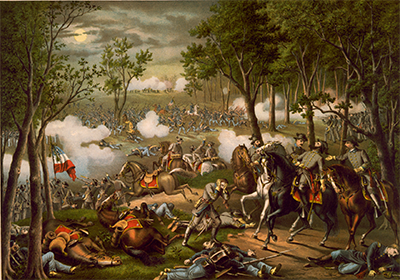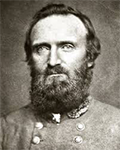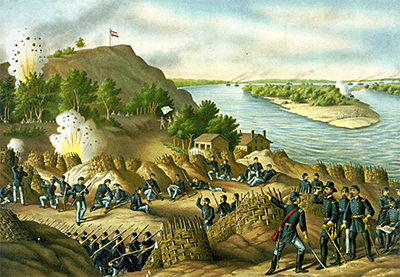The American Civil War
Part 5: Chancellorsville and Vicksburg Hooker spent the spring of 1863 shoring up his force, giving wounded soldiers time to heal and starving soldiers time to replenish their strength. The Confederate force, on the other hand, needed supplies and so a large part of it went foraging, leaving Lee and his men outnumbered 2–1. Hooker knew the state of play and employed his strategy. He hoped to catch the Confederate forces unaware by having Union troops cross the Rappahannock River (over which Burnside had led his troops in retreat after the Battle of Fredericksburg) further upstream and then fall on the Confederate army from the rear. Heavy rains prevented that approach, but Hooker stuck to the plan. A total of 42,000 made that crossing. A further 40,000 troops led by Maj. Gen. John Sedgwick were to cross the river south of Fredericksburg and hit the Confederate right flank. Hooker's attempt at concealment was to have 25,000 men stay right where they were, appearing as though they were still resting up from the cold hard winter. The troops crossed the river successfully at both points, on April 27 and April 30. As a result, the Union force at Chancellorsville numbered 70,000. Not for the first or last time, Lee divided his outnumbered force and, even though heavily outnumbered, ordered his men to attack. 
Despite his reputation for taking the initiative, Hooker chose to dig in at Chancellorsville, trusting in his troops' defensive capabilities. (His commanders had urged him to at least take the nearby high ground, but Hooker demurred.) The one part of the Union army as positioned at Chancellorsville that wasn't as strong as the others was the right flank. It was this point that Gen. Stonewall Jackson and his men had reached in the early evening on May 2, by stealing through a woods that concealed their movements. The Confederate attack coincided with mealtime in the Union camp, and the result was a hammer blow for Jackson's troops, including 4,000 captured Union soldiers. The right flank fell back, and confusion reigned in the Union ranks. They did not retreat, however; a brief Union counterattack forced a lull in the fighting. 
Later that night, Jackson (right) wanted to know whether a nighttime attack would work, so he and a few of his troops rode out to have a look. When they returned, a handful of Confederate soldiers thought that they were the enemy and opened fire. Jackson sustained three bullet wounds and ended up having his left arm amputated. As happened so often during this time in history, an infection accompanied the operation, and Jackson died, on May 10. Meanwhile, on May 5, Hooker became convinced that he couldn't win and so ordered a full-scale retreat. In the West, the major target at the end of 1862 was Vicksburg. A December 1862 assault by men of Maj. Gen. William T. Sherman's corps met with heavy resistance, was unsuccessful, and resulted in heavily uneven casualties: 1,800 Union and 200 Confederate. Subsequent land-based initiatives failed to make progress, and Grant, commander of the main land force, decided to coordinate army and navy actions. Commanding the Vicksburg garrison was Lt. Gen. John C. Pemberton. This commander was from Pennsylvania but had chosen to fight for the Confederacy in deference to his Southern wife. Hoping to sever the Union supply line, he marched out of Vicksburg with 17,500 troops. The result was the Battle of Champion's Hill, a Union victory. Again, at Big Black River Bridge, the two sides traded blows. Again, Union forces prevailed. Pemberton led his men back to Vicksburg, burning bridges behind them as they went. Pemberton had ordered constructed a series of defenses on the perimeter of the vital city. Union troops threw themselves into the fighting time and again and sustained heavy casualties. Grant then decided that the way to take Vicksburg was by siege. 
By the end of June, Union forces numbered 70,000 and Confederate forces numbered 30,000. The defenders were ensconced behind thick walls and had the benefit of the high ground; however, they were surrounded and no longer had access to reliable supply lines. In fact, the city had been cut off for several weeks. Union troops built 15 miles of trenches around the city and then, their supply lines intact, settled in to wait. Day after day, shells from Union guns on land and on ship rained down on Vicksburg. The people inside the city hid in caves and resorted to eating animals to survive. On July 3, Pemberton agreed to surrender. Grant, accepting the terms, allowed the parole of the captured soldiers. On July 4, more than 29,000 Confederate soldiers marched out of the city and piled up their guns as a symbol of their surrender. Vicksburg was in Union hands, as was the Mississippi River. The last Confederate-held stronghold on the river, Port Hudson, also surrendered. |
|
Social Studies for Kids
copyright 2002–2025
David White




